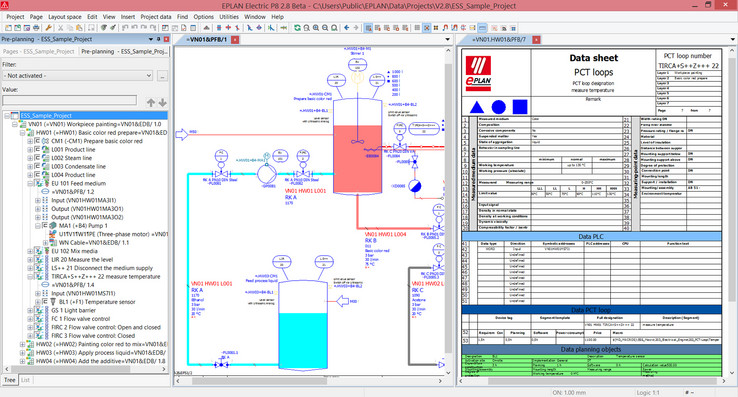EPLAN Preplanning, Version 2.8
Solutions provider EPLAN bridges the gap between the design phase and interdisciplinary detail engineering. Numerous new features and improvements in EPLAN Preplanning allow easier updating of previously assigned macros, improved importing of filtered Excel lists, and optimal segment placement. All of the new upgrades strengthen ideal planning processes in which project data are entered and enhanced earlier in the project and can also be processed without media disruption. In Hamburg at the SMM, the leading trade show for the maritime industry, EPLAN will be presenting first glimpses of EPLAN Preplanning, Version 2.8, which helps make the complexity of shipbuilding and other large projects even more manageable.
Solutions provider EPLAN bridges the gap between the design phase and interdisciplinary detail engineering. Numerous new features and improvements in EPLAN Preplanning allow easier updating of previously assigned macros, improved importing of filtered Excel lists, and optimal segment placement. All of the new upgrades strengthen ideal planning processes in which project data are entered and enhanced earlier in the project and can also be processed without media disruption. In Hamburg at the SMM, the leading trade show for the maritime industry, EPLAN will be presenting first glimpses of EPLAN Preplanning, Version 2.8, which helps make the complexity of shipbuilding and other large projects even more manageable. Monheim, Germany, 27 August 2018 – The new EPLAN Platform, Version 2.8 will be available in just a few weeks, with first glimpses of it being shown at the SMM in Hamburg. With EPLAN Preplanning, users benefit from numerous optimisations in the preliminary design phase – for instance with placing segments. In Version 2.8, they can now be placed multiple times, allowing a segment to be displayed across multiple preplanning pages. For placement, users can also start graphical preplanning at any node in the structure, allowing multiply nested segments to be displayed on multiple preplanning pages. This clear overview gives more transparency and facilitates orientation even in large projects. Another practical advantage: cross-references can now be shown on the segments if the corresponding counterpart to the segment exists. These were usually placed in the detail engineering – for instance in the P&I flowchart or in the multi-line schematic – or on other preplanning pages. This provides a better overview of the design and simplifies segment assignments. The segment definitions have also been made easier to use: flexible numbering settings for configuration provide users more leeway.
Certainty when generating schematics
If schematics are to be derived from the preliminary preplanning data in detail engineering, it is important to keep an overview. The aim is always a clear connection between the planning object and the associated schematic. Beforehand, a planning object with an assigned macro could be used multiple times in the page navigator. This had the unfortunate effect of potentially doubling pages – yet a schematic for a planning object can only exist as a singular. The new Version 2.8 directly supports users from scratch. If the schematic pages for a planning object have already been generated, users receive a corresponding system message with the necessary details. This ensures faultless planning and quicker results.
Easily update assigned macros
Macro technology considerably simplifies project development with the reuse of previously defined objects such as schematic templates. Now even more information is visible for the planning object with the integration of an additional information line. If a previously assigned macro in a schematic is changed, the value sets are modified, and this information can now be easily stored. Furthermore, the system behaviour for stored macros with changed placeholder objects has also been improved. Numerous properties in the schematic can be controlled via value sets. Inconsistent information between preplanning and schematic are a thing of the past.
Importing filtered Excel lists
When preliminary plans are drawn up, lists with preplanning data created in external applications can be imported. What’s new here is that a filter set up in Excel will now be recognised. Incorporating filtered Excel lists reduces the preplanning data shown in the synchronisation dialogue, thereby making importing clearer and quicker. In addition, more extensive Excel files can now be imported even faster.
Conclusion
EPLAN Preplanning bridges the gap between the design phase and interdisciplinary detail engineering. The numerous improvements to Version 2.8 make it even easier to update the detail engineering. All components and schematics relevant to the electrical design can be put into EPLAN Preplanning and made available to downstream engineering disciplines without any loss of information. It helps make the complexity of large projects even more manageable, particularly in shipbuilding. EPLAN Tutorials ©EPLAN Software & Service, August 2018



